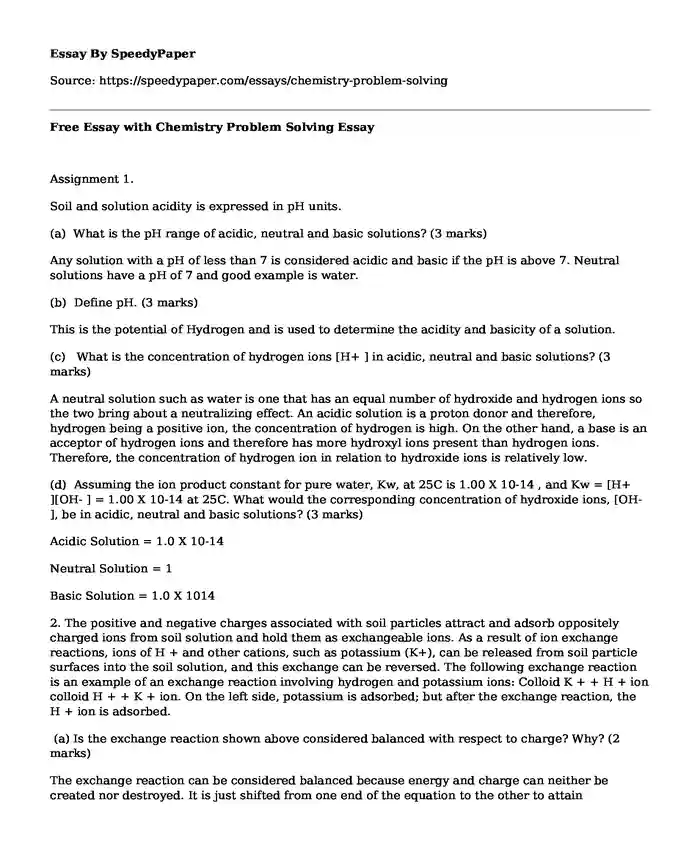
| Type of paper: | Problem solving |
| Categories: | Problem solving Chemistry |
| Pages: | 3 |
| Wordcount: | 716 words |
Assignment 1.
Soil and solution acidity is expressed in pH units.
(a) What is the pH range of acidic, neutral and basic solutions? (3 marks)
Any solution with a pH of less than 7 is considered acidic and basic if the pH is above 7. Neutral solutions have a pH of 7 and good example is water.
(b) Define pH. (3 marks)
This is the potential of Hydrogen and is used to determine the acidity and basicity of a solution.
(c) What is the concentration of hydrogen ions [H+ ] in acidic, neutral and basic solutions? (3 marks)
A neutral solution such as water is one that has an equal number of hydroxide and hydrogen ions so the two bring about a neutralizing effect. An acidic solution is a proton donor and therefore, hydrogen being a positive ion, the concentration of hydrogen is high. On the other hand, a base is an acceptor of hydrogen ions and therefore has more hydroxyl ions present than hydrogen ions. Therefore, the concentration of hydrogen ion in relation to hydroxide ions is relatively low.
(d) Assuming the ion product constant for pure water, Kw, at 25C is 1.00 X 10-14 , and Kw = [H+ ][OH- ] = 1.00 X 10-14 at 25C. What would the corresponding concentration of hydroxide ions, [OH- ], be in acidic, neutral and basic solutions? (3 marks)
Acidic Solution = 1.0 X 10-14
Neutral Solution = 1
Basic Solution = 1.0 X 1014
2. The positive and negative charges associated with soil particles attract and adsorb oppositely charged ions from soil solution and hold them as exchangeable ions. As a result of ion exchange reactions, ions of H + and other cations, such as potassium (K+), can be released from soil particle surfaces into the soil solution, and this exchange can be reversed. The following exchange reaction is an example of an exchange reaction involving hydrogen and potassium ions: Colloid K + + H + ion colloid H + + K + ion. On the left side, potassium is adsorbed; but after the exchange reaction, the H + ion is adsorbed.
(a) Is the exchange reaction shown above considered balanced with respect to charge? Why? (2 marks)
The exchange reaction can be considered balanced because energy and charge can neither be created nor destroyed. It is just shifted from one end of the equation to the other to attain equilibrium.
(b) Would the above reaction tend to occur in acidic or basic soils? Explain. (2 marks)
The reaction is less likely to occur in acidic or basic soils; this is because they have a surplus of free ions that will neutralize the positive and negative ions hence producing a neutral effect.
(c) How might the reaction be reversed, or driven to the left? (2 marks)
Forward reaction (to the right) is favored by addition of protons which in this case is Hydrogen and Potassium ions. Therefore, reverse reaction will be favored by addition of negative ions. Addition of negative ions such as hydroxide ions will trigger formation of Colloid K instead of Colloid H.
3. The net positive charge of soil particles can be expressed in terms of cation exchange capacity, measured in moles of positive charge.
(a) How many charges are contained in one mole of charge? (1 mark)
96485.33289 C as per the Faradays constant
(b) What does a mole of magnesium weigh? (1 mark)
Approximately 24g which is the sum of neutrons and protons since electrons no relative weight
(c) What mass of magnesium is needed to provide 1 centimole of positive charge (1 cmolc)? (1 mark)
24 X 0.01 = 0.24g
4. Assuming a kilogram of the Ap horizon of a loam soil (20% clay, 40% silt, 40% sand) contains 5% organic matter and that the clay fraction is a mixture of fine mica and chlorite, please calculate the following.
(a) What would be the CEC (cmolc) associated with the clay fraction? (2 marks)
20% of 1000 = 200 (Amount in grams/mol)
200 X 0.01 = 2 (Amount in grams/cmolc)
(b) What would be the CEC (cmolc) associated with the organic fraction? (2 marks)
5% of 1000 = 50 (Amount in grams/mol)
50 X 0.01 = 0.5 (Amount in grams/cmolc)
(c) What would be the total CEC of a kilogram of this soil, assuming the silt and sand did not contribute any charge? (1 mark)
Answer of a + Answer of b = Answer of c
Answer = 2.5 CEC
(e) If this loam had a base saturation of 50%, how many centimoles of exchangeable bases are present per kilogram of soil? (2 marks)
50% of 2.5 = 1.25CEC
Cite this page
Free Essay with Chemistry Problem Solving. (2017, Aug 27). Retrieved from https://speedypaper.com/essays/chemistry-problem-solving
Request Removal
If you are the original author of this essay and no longer wish to have it published on the SpeedyPaper website, please click below to request its removal:
- Civil War Essay Sample: Crittenden Compromise and Missouri Compromise
- Essay Example on the US Strategic Defense Initiative
- Free Essay Example on the Global Obesity Scourge
- Essay Example on the United States Involvement in Vietnam
- Accounting Essay Example
- The Benefits of Mindfulness
- Essay Sample Describing the Value of Forecasting
Popular categories




